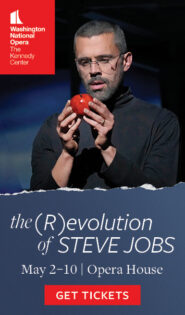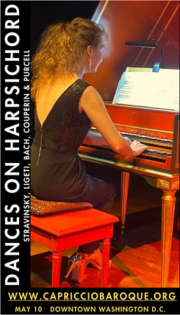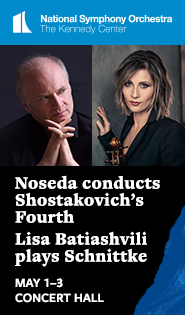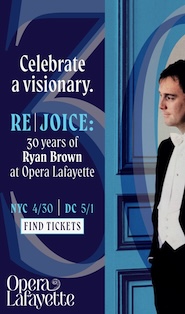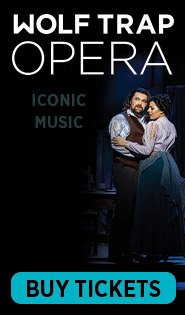Wolf Trap offers wintry charms on ideal summer night with a painterly “Bohème”
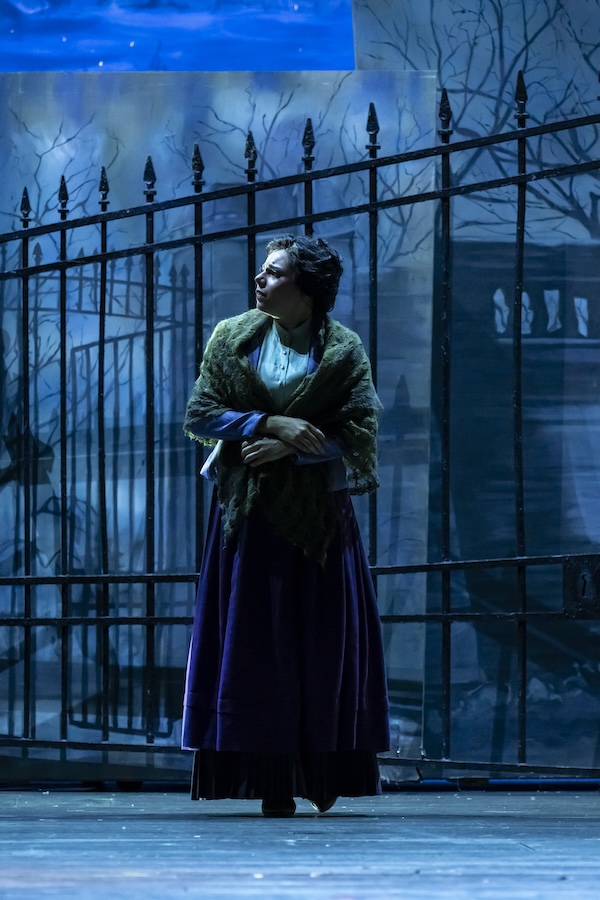
Amanda Batista as Mimi in Wolf Trap Opera’s La Bohème Friday night. Photo: Scott Suchman
The summer opera stars aligned for a delightful experience Friday evening at Wolf Trap. With no rain or humidity, a cool breeze set the ideal temperature for a near-capacity crowd at the Filene Center, both under the venue’s roof and picnicking on the lawn. With the National Symphony Orchestra gathered in the pit, Wolf Trap Opera Company fielded a solid cast of young singers for a worthy production of Giacomo Puccini’s evergreen La Bohème.
One singer stood out for exceptional praise. Amanda Batista, who has already made quite an impression in the Metropolitan Opera’s Lindemann Young Artist Development Program, made a consummate Mimi, both musically and dramatically. The soprano proved the complete package vocally, with clarion high Cs, but more than just bravado power, with the ability to rarefy and sweeten the top notes into heart-rending softness.
Batista’s portrayal of the ailing seamstress wasted away by tuberculosis rang true physically as well. It is a double shame that this production ran for only this one night and that Batista will not be featured again at Wolf Trap this season. Opera fans should take the opportunity to hear her with the company next season, when hopefully she returns.
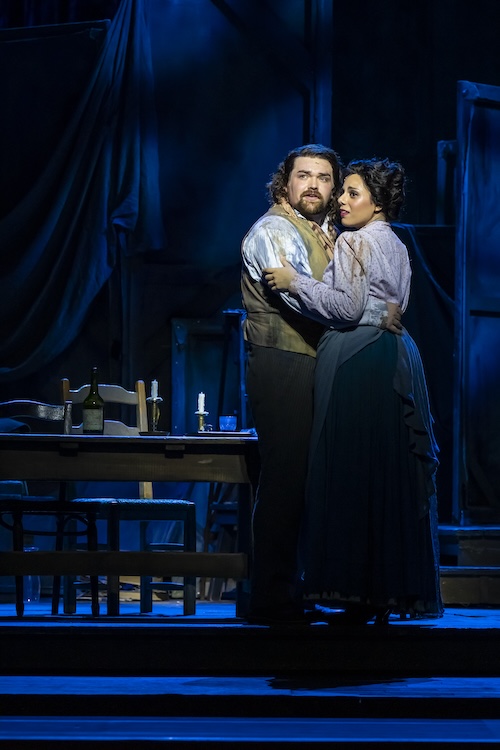
Eric Taylor as Rodolfo and Amanda Batista as Mimi in La Bohème. Photo: Scott Suchman
The Rodolfo of Eric Taylor could not quite measure up in comparison. The Utah-born tenor, as he showed in the title role in last season’s Faust, displayed energy and talent but with some rough edges. His top notes rang out in the crucial Act I aria, “Che gelida manina,” but revealed some weakness toward the end of Act III. As an actor, he captured the right combination of the poet’s expressive excesses and certainly his bereft reaction to Mimi’s tragic death.
Blake Denson, who sang the role of Schaunard in Washington National Opera’s production of the opera last year, made a fine Marcello as well. His supple baritone came through the venue’s sometimes problematic amplification system with clarity, and he brought both lyrical singing and charming humor to the role of the frustrated painter. Midori Marsh plied an acidic soprano edge to her Musetta, visibly relishing the histrionics of her Act II Waltz scene.
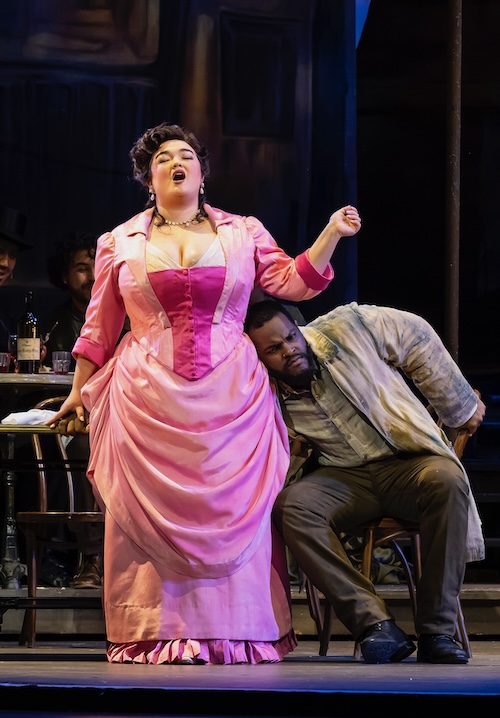
Midori Marsh as Musetta and Blake Denson as Marchello in Wolf Trap Opera’s La Bohème. Photo: Scott Suchman
Rounding out a rambunctious male quartet were the gallant Schaunard of Laureano Quant and the gentle giant Colline of Le Bu. The Colombian-born baritone consistently provided comic relief in the light-hearted parts of Acts I and IV, while the Chinese-born bass’s bookish philosopher was a steady force, most effective in Act IV’s melancholy coat aria, one of the score’s many melodic high points.
Wolf Trap Opera Studio Artists rounded out the comprimario roles, with bass-baritone Adam Partridge scoring comic points as Benoit and Alcindoro. Studio Artists also joined the chorus, who contributed strongly in Acts II and III, especially the women’s voices. The Children’s Chorus of Washington gave pep to the Christmas Eve crowd scene in Act II with charming action and vocal character.
At the podium, conductor Grant Gershon proved much more effective this time around than in his previous attempt at the opera in 2016. Placing the NSO in the pit, rather than at the back of the stage, surely helped him coordinate better with the singers, but what came across equally was a more mature, developed approach to the score. Tempos bounced in the more active scenes, but Gershon did not shy away from drawing out the poignant moments with plenty of rubato.
The final element of the evening’s success was the charming production created by John Caird, already seen at Houston Grand Opera and Canadian Opera Company, among others. Caird not only kept the action in its intended time period, a choice rare enough among modern opera directors, but he consistently read the libretto closely. At the end of Act III, for example, he had Musetta leave with the man Marcello has seen her flirting with, a savvy addition.
The costumes (designed by David Farley) and the acting direction, handled in this revival as in others by Katherine M. Carter, hewed closely to the intentions of the opera’s creators. That kind of respect for the libretto is no longer a given among many current intrusive opera directors, and Carter naturally heightened the dramatic effect throughout rather than working against it.
Farley’s unusual conception for the scenic design centered on the paintings of Marcello. The scrim that appeared before the opera and at intermission featured sketches of women, in a style reminiscent of Henri de Toulouse-Lautrec, intermingled with writing. Large canvases leaning up against one another formed most of the structure of Act I’s garret. In the middle acts the paintings, now depicting the Parisian scenes themselves, also formed much of the backdrop. Visually appealing, this conceit also cleverly signaled life’s imitation of art, and vice-versa.
Wolf Trap Opera Company concludes its season with a production of Kevin Puts’ Silent Night, August 9-17. wolftrap.org
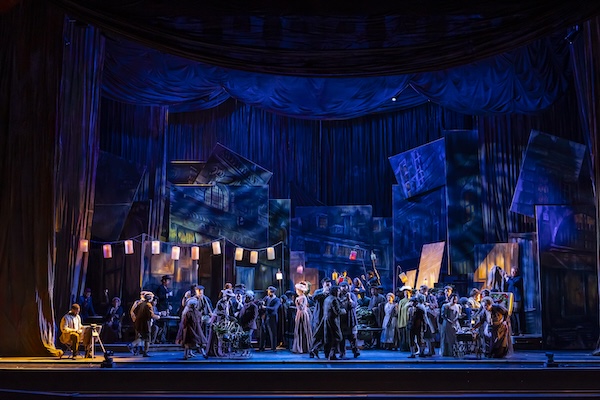
Photo: Scott Suchman
